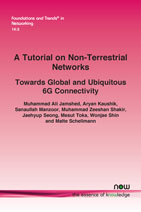A Tutorial on Non-Terrestrial Networks: Towards Global and Ubiquitous 6G Connectivity
By Muhammad Ali Jamshed, University of Glasgow, UK, muhammadali.jamshed@glasgow.ac.uk | Aryan Kaushik, Manchester Metropolitan University, UK, a.kaushik@ieee.org | Sanaullah Manzoor, Glasgow Caledonian University, UK, sanaullah.manzoor@gcu.ac.uk | Muhammad Zeeshan Shakir, University of the West of Scotland, UK, muhammad.shakir@uws.ac.uk | Jaehyup Seong, Korea University, South Korea, jaehyup@korea.ac.kr | Mesut Toka, Gebze Technical University, Turkey, mtoka@gtu.edu.tr | Wonjae Shin, Korea University, South Korea, wjshin@korea.ac.kr | Malte Schellmann, Huawei Munich Research Center, Germany, malte.schellmann@huawei.com
Abstract
The International Mobile Telecommunications (IMT)-2030 framework recently adopted by the International Telecommunication Union Radiocommunication Sector (ITU-R) envisions 6G networks to deliver intelligent, seamless connectivity that supports reliable, sustainable, and resilient communications. To achieve this vision, Non-Terrestrial Networks (NTN) represent a significant advancement by extending connectivity beyond the Earth's surface. These networks integrate advanced communication technologies that go beyond conventional terrestrial infrastructure, enabling comprehensive global connectivity across domains such as the Internet, Internet of Things (IoT), navigation, disaster recovery, remote access, Earth observation, and even scientific initiatives like interplanetary communication.
Recent developments in the 3rd Generation Partnership Project (3GPP) Releases 17-19, particularly within the Radio Access Network (RAN)4 working group addressing satellite and cellular spectrum sharing and RAN2 enhancing New Radio (NR)/IoT for NTN, highlight the critical role NTN is set to play in the evolution of 6G standards. The integration of advanced signal processing, edge and cloud computing, and Deep Reinforcement Learning (DRL) for Low Earth Orbit (LEO) satellites and aerial platforms, such as Uncrewed Aerial Vehicles (UAV) and high-, medium-, and low-altitude platform stations, has revolutionized the convergence of space, aerial, and Terrestrial Networks (TN). Artificial Intelligence (AI)-powered deployments for NTN and NTN-IoT, combined with Next Generation Multiple Access (NGMA) technologies, have dramatically reshaped global connectivity.
This monograph provides a comprehensive exploration of emerging NTN-based 6G wireless networks, covering vision, alignment with 5G-Advanced and 6G standards, key principles, trends, challenges, real-world applications, and novel problem solving frameworks. It examines essential enabling technologies like AI for NTN (LEO satellites and aerial platforms), DRL, edge computing for NTN, AI for NTN trajectory optimization, Reconfigurable Intelligent Surfaces (RIS)-enhanced NTN, and robust Multiple-Input-Multiple-Output (MIMO) beamforming. Furthermore, it addresses interference management through NGMA, including Rate-Splitting Multiple Access (RSMA) for NTN, and the use of aerial platforms for access, relay, and fronthaul/backhaul connectivity.
A Tutorial on Non-Terrestrial Networks: Towards Global and Ubiquitous 6G Connectivity
The International Mobile Telecommunications (IMT)-2030 framework recently adopted by the International Telecommunication Union Radio Communication Sector (ITU-R) envisions 6G networks to deliver intelligent, seamless connectivity that supports reliable, sustainable, and resilient communications. To achieve this vision, Non-Terrestrial Networks (NTN) represent a significant advancement by extending connectivity beyond the Earth’s surface. These networks integrate advanced communication technologies that go beyond conventional terrestrial infrastructure, enabling comprehensive global connectivity across domains such as the Internet, Internet of Things (IoT), navigation, disaster recovery, remote access, Earth observation, and even scientific initiatives like interplanetary communication.
Recent developments in the 3rd Generation Partnership Project (3GPP) highlight the critical role NTN is set to play in the evolution of 6G standards. The integration of advanced signal processing, edge and cloud computing, and Deep Reinforcement Learning (DRL) for Low Earth Orbit (LEO) satellites and aerial platforms, such as Uncrewed Aerial Vehicles (UAV) and high-, medium-, and low-altitude platform stations, has revolutionized the convergence of space, aerial, and Terrestrial Networks (TN). Artificial Intelligence (AI)-powered deployments for NTN and NTN-IoT, combined with Next Generation Multiple Access (NGMA) technologies, have dramatically reshaped global connectivity.
This monograph provides a comprehensive exploration of emerging NTN-based 6G wireless networks, covering vision, alignment with 5G-Advanced and 6G standards, key principles, trends, challenges, real-world applications, and novel problem solving frameworks. It examines essential enabling technologies like AI for NTN (LEO satellites and aerial platforms), DRL, edge computing for NTN, AI for NTN trajectory optimization, Reconfigurable Intelligent Surfaces (RIS)-enhanced NTN, and robust Multiple-Input-Multiple-Output (MIMO) beamforming. Furthermore, it addresses interference management through NGMA, including Rate-Splitting Multiple Access (RSMA) for NTN, and the use of aerial platforms for access, relay, and fronthaul/backhaul connectivity.
